
Review samples supplied by Antipodes Audio
Retail price (world) USD 9.000 excluding storage
Upgrade price G3 to G4 USD 2.000
Storage can be included at purchase or later installed by the user
Available in Black or Silver
Part of the KALA series, the Antipodes K22 offers the best performance the New Zealand company can squeeze out of a server/streamer at its price point. As the manufacturer puts it, “The KALA 22 gets very close to the performance of the amazing KALA 50 provided you do not require it to house a very large library, or to perform DSP functions”.
K22 contains the K50’s acclaimed Player and Re-clocker Engines and includes a medium-power Server so that it can be used as a high-end streaming endpoint or a relatively affordable all-in-one music server. Naturally, the range-topping K50, with its high-power server, performs on a higher level than the K22, but as I found during my review of the previous generation K22, the “sacrifice” is considerably smaller than one might assume.
Given its superb Player and Re-clocker Engines, the K22 is also ideal for those who predominantly stream from cloud services like Qobuz or Tidal.
As part of the G4 update, the K22 is now fitted with proprietary Antipodes isolation footers, which were derived from the Oladra’s constrained-layer footers. Instead of the hard-soft-hard layer sandwich, the K22 consists of two layers, with the soft layer (the blue slice) at the bottom.
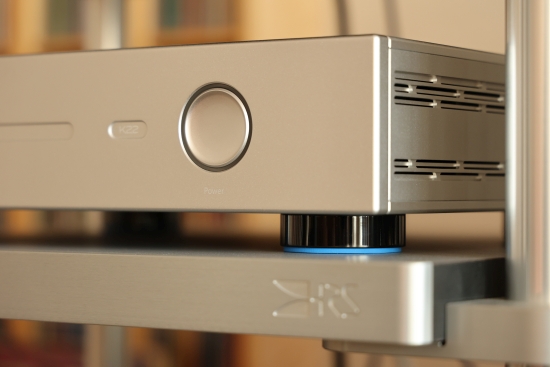
The update also includes incorporating the Oladra’s triple-cascade power supply technology, an update to the Player engine, and the installation of a new USB output. The latter is quite a big one as it is said to lift the USB sound quality to match that of the Reclocker S/PDIF, AES/EBU, and I2S outputs. Other benefits include an increase of 200% to 400% in system resources to improve system responsiveness and enterprise-level OS resilience against data loss in unusual AC power events.
The beauty of the current KALA range is that it allows an entry level for all budgets while allowing maximizing the performance in the area(s) that matter most to the individual owner. At the same time, the available options make it easy to start at an affordable level and upgrade to a higher level later when funds permit while protecting the investment made. Moreover, as with all KALA models, the K22 is designed to be upgradable when Antipodes release improvements to the model.
KALA Upgrade Path
There are three entry options with the ability to upgrade to KALA 50 level later.
- Start with a KALA 41 as Server and stream to the Ethernet input on your DAC. Upgrade the sound quality later to KALA 50 level by adding a KALA 21 or KALA 22.
- Start with a KALA 22 for Server and Player to play to the USB, S/PDIF, AES3 or I2S input on your DAC. Upgrade the sound quality later to KALA 50 level by adding a KALA 41 to take over the Server function.
- Start with a KALA 21 for Server and Player to play to the USB input on your DAC. Upgrade the sound quality to KALA 50 level over USB by adding a KALA 41 to take over the Server function.
The KALA 41 & KALA 22 combination is identical to the KALA 50 in cost, electronically, and in all performance areas. The KALA 41 and KALA 21 combination is identical to the performance of the KALA 50 when using the KALA 50’s USB output at a more affordable price.
K22 in a Nutshell
What you pass up on with the K22 versus the K50 is restricted only to the server part is and predominantly related to its processing power. The K22 cannot run the HQPlayer Server App but supports HQPlayer NAA. All other apps in the Antipodes software suite are supported, with the exception of the DSP features within the apps.
The K22 uses a single custom computer for both Server and Player apps. More precisely, the Server/Player engine is derived from the Player engine in the K50 but with increased processing resources. The outputs are the same, except that Ethernet streaming to a networked DAC is over the network, whereas the K50 and K41 additionally provide Direct Streaming connections.

The medium-power Server/Player computer controls what is played and allows you to play over your network to multiple endpoints and to the DAC in your main system via its built-in USB, S/PDIF, AES3 & I2S outputs.
AMS v5.0.0 Web Interface
The K22 includes the latest AMS v5 web interface which is the gateway to your Antipodes server, where you can check and change all of its settings. Since version 4, Antipodes has simplified the process of accessing the Web Interface by integrating this into their main website. To access the Web Interface, simply go to “antipodes.audio” and click “Setup” in the top menu.
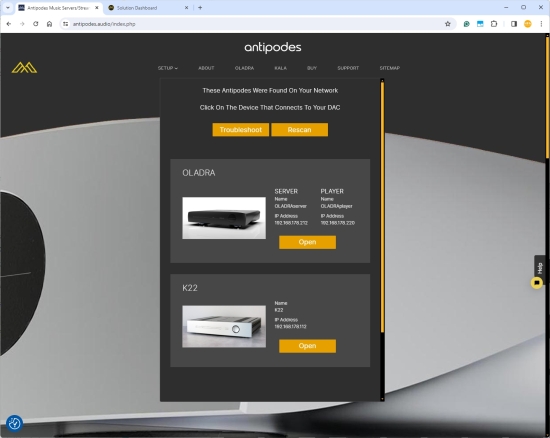
After clicking K22, the Solution Dashboard is shown, which contains all the functionality you need to quickly set up the server as desired, such as Playback Method, Audio Output, DSD Method, and an update button. V5 combines all information on a single screen, replacing the separate screens for the server and player. Now, you can quickly see all the important information at a glance, such as CPU usage, memory usage, software version, MAC address, IP address, etc.
AMSv5 Solution Dashboard:
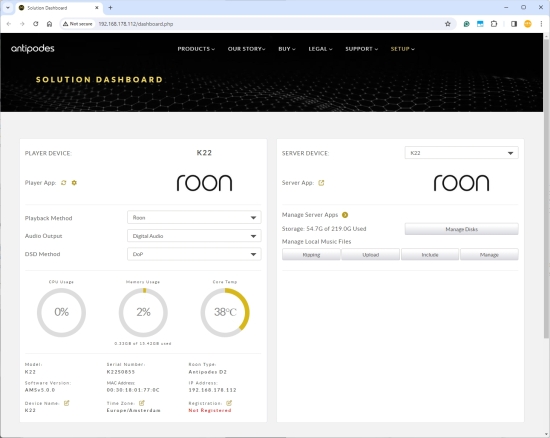
The software not only looks great but also works super-intuitively. Below, you can see the Playback Method pull-down Menu, showing all the player options.
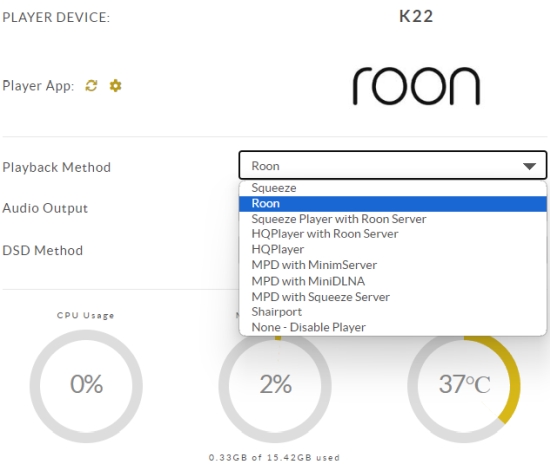
By selecting a pre-configured solution above, the server and player sections are prepared at the same time. Naturally, you can also change the preset configurations just as you like.
As with all Antipodes models, users can easily choose and switch between using Squeeze server/player, Roon, Squeeze player with Roon Server, MPD with Minimserver, UPnP/DLNA (MiniDLNA), or Squeeze Server, HQPlayer, and Shairport, right from the AMS web interface.
Although using only one Server App at a time is recommended for the best Sound Quality, you can simultaneously enable as many as you like in the Server Apps Dashboard. Besides the mentioned apps, you can also enable Plex and Sonos.
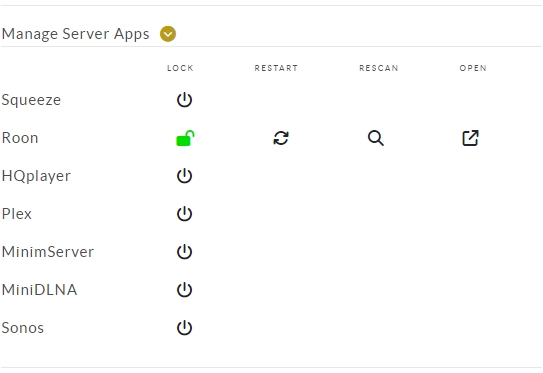
Various other screens allow full control of every aspect of the server and player apps, right down to diagnostics, troubleshooting, and even booking a support session. Please see the Guides section on the Antipodes website for all the ins and outs.
Next: Review Context and Listening
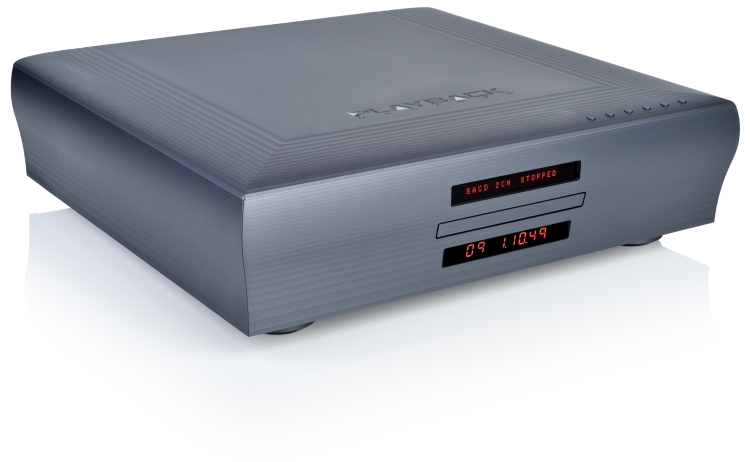






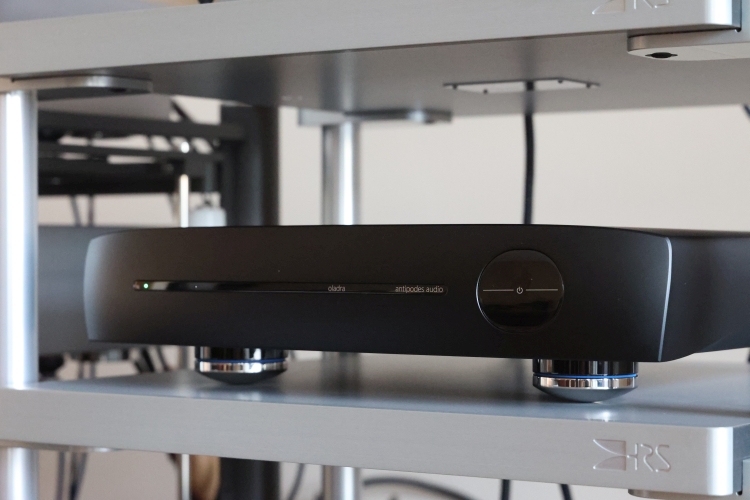
Hi Christiaan,
another great review!
As you promised in the comments for your JPLAY for iOS review I would like to ask you about the comparison of K22 vs LinQ. I think it makes sense to compare them in the configuration where both sound best. Personally I am not interested in a configuration with Roon involved. Thank you very much.
Sorry, I forgot to mention please consider only streaming from Qobuz and not playback of local files. Thanks again.
Hi Matt, comparing the Antipodes K22 to the Aqua LinQ both as a streaming endpoint via UPnP controlled from JPLAY for iOS, providing signal via a Jorma AES/EBU cable to the CH C1.2 DAC, the K22 offers a tonally fuller, creamier, more voluptuous, darker rendition whereas the LinQ offers a tighter, leaner, more open, and expressive rendition. The K22 also feels more spacious whereas the LinQ feels more focused. The magnitude of the difference becomes smaller when using the LinQ’s HQP UPnP engine (instead of the standard UPnP input) but the relative differences remain. When using the K22 with USB, the magnitude of the difference is further reduced, but still, the typical Antipodes traits such as smoothness and tonal saturation remain evident. In a nutshell: the LinQ is more precise and transparent but can also be perceived as dry, lean, or analytical whereas the K22 is smoother and more forgiving but less transparent and revealing.
Hoi Christiaan,
Thank you for expressing your thoughts. I particularly value your feedback following our recent discussion about the Oladra G4. I’m pleased to see the incorporation of Squeeze to Squeeze in your review, and it comes as no surprise that opting for Squeeze for both player and server can significantly enhance the performance of any Antipodes server.
As I recently wrote on the Antipodes forum:
“ I have complete faith in Christiaan’s observations, and I’ve noticed and have let him know that lately he’s been approaching his writing more from the perspective of a Roon user. It’s not because he lacks knowledge or prefers Squeeze less; it seems to be a matter of convenience. However, his latest review truly highlights the strengths of Squeeze + Squeeze, which is also a testament to the efforts Antipodes has been making to propel Squeeze in the right direction.”
I also encourage Antipodes users to explore alternative combinations, such as SqueezePlayer with Roon server and the three MPD presets. However, it’s worth noting that there’s no wrong choice here; each option offers its own merits.
_ _ _
antipodes.support/t/audiophile-style-reviews-antipodes-audio-kala-k50/1962/60?u=paulw
(Links are not permitted here, please paste above in your browser)
Thank you for the feedback and support, Paul!
Hoi Christiaan, graag gedaan.
Thank you for this review. The Antipodes K22 along with the Playback Design MPS-X (which you reviewed last year) are the two streamers I am considering. Which one would you prefer? Would the PLINK connection to the Playback Design DAC nudge you in that direction? Of course there is nothing stopping one from connecting the K-22 to the MPD-6, but would it be as good as with a total Playback Designs setup?
With Playback Designs, you’ll still need a server section unless you use streaming services only. Other than this, it is a very personal matter. I found PLINK to be the best interconnect format for Playback Designs devices but I would not use this as the main deciding factor. These are two very different sounding solutions so it really depends on what sonic signature you are looking for. The Playback Designs MPS-X sounds leaner and more agile in the bass and is airier, more refined and more transparent, while the Antipodes K22 sounds fuller and more ponderous in the bass and is tonally more saturated, darker, and harmonically richer.
Hi Christiaan, thanks for the in-depth review. It is your Antipode reviews that triggered my attention for the brand. I have a K22 and K41. I sent the K22 for upgrade just before your review came out. Are you planning also to do a K41 G4 review? I am curious which improvements might be discovered there (and my K41 is a G3)
Thanks in advance for considering…
There are currently no other Antipodes reviews planned but one never knows what the future may bring:-) That said, I think you can get a good indication by extrapolating the noted differences between G3 K22 and G4 K22 to the K41.
Thanks for great review! I like that you compare sound to other brands/models. I would like to see an easy way to find your latest reviews, e.g. sorting the reviews by date. Most review sites have the latest review on top.
Thanks:-) If you scroll down on the main page, you see the “Reviews in Progress” and further down, you see “Latest Posts”, in order of appearance, with the latest ones on top. Were these perhaps missed or are you referring to something else? In the review categories, I did indeed opt for showing them alphabetically, as that is what I was missing on many other sites at the time. For me, it was not handy seeing them in order of appearance, as I was typically looking for a certain brand or model. Nevertheless, I am open to suggestions to making the site better. At some point, it will need an overhaul, and I will take such suggestions on board.
Hi Mikael, I’m happy to confirm I have now implemented sorting by date (latest articles on top) by default. I hope you like it!
Hi Christiaan,
Just finished reading your review on the K22, excellent job thank you. My question to you is for streaming only is the K22 the same as K50 or below it in sound quality?
Thank you in advance
Hi Inaet, While the K50 and K22 share the same playback engines, they have different power supplies, and probably a few other key differences. In any event, they are close, but not identical in quality. You will hear this predominantly in the low-level resolution and refinement. As the manufacturer puts it, “The KALA 22 gets very close to the performance of the amazing KALA 50 provided you do not require it to house a very large library, or to perform DSP functions”. I found this holds true when using the local library, as well as when using a cloud-based streaming source via Roon or JPLAY. I’d wager it also still holds true when streaming directly to it from a cloud service app.
I started using Antipodes after reading Christiaan’s excellent writing here, and I was never disappointed.
I’ve also been using the Antipodes K50, and the biggest advantage it has over the K22 comes down to its dual-computer design. The K50 has both a high-powered server board and a low-powered player board, each with separate power supplies. This setup keeps noise and interference to a minimum, leading to better resolution, separation, and overall musical flow.
The K22, on the other hand, is a single-box solution that only has the player board. It can function as both a server and a player in one unit, but because everything is happening on a single board, it doesn’t quite match the K50 in terms of refinement and detail. That said, the K22 still delivers excellent dynamics, tonal density, and musical engagement.
When used as a player only you can pair it with an external server—whether that’s Antipodes’ K41 or a high-quality server from another brand. Of course, using a separate server introduces potential noise and cable management challenges, but the tradeoff is the flexibility to optimize your system. The K50, on the other hand, solves this by integrating both functions into one box for a fully optimized, all-in-one solution.